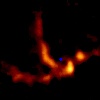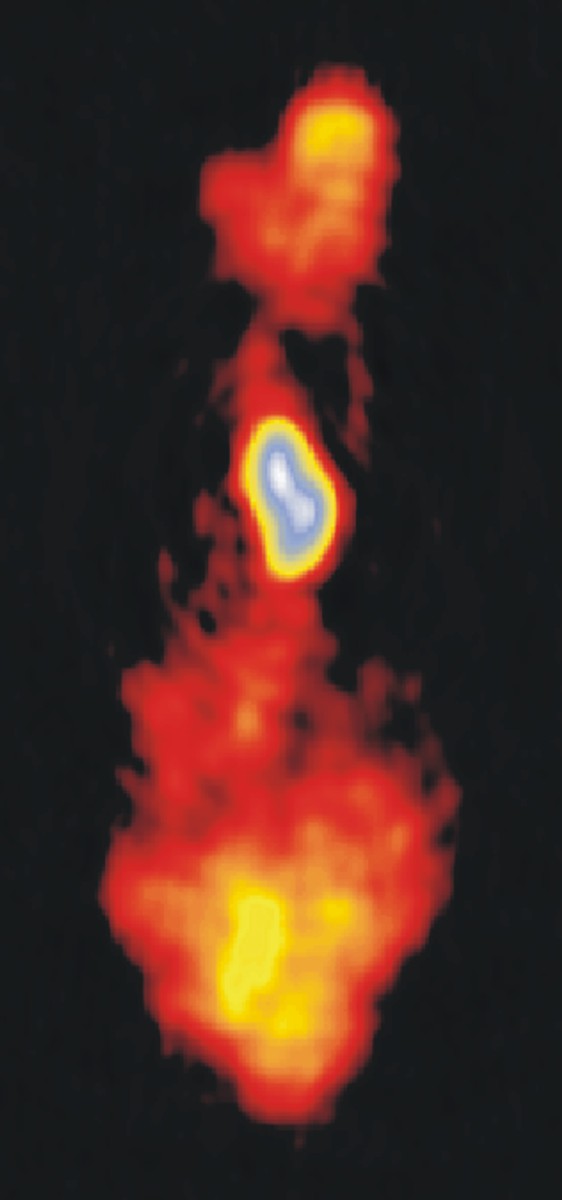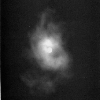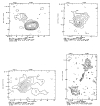| Clusters of Galaxies | |||||||||||||
|
Courtesy: NRAO/AUI
Abstract Located at the center of the Perseus cluster, 3C84 is a strong radio source. With the SMA and CARMA, we are monitoring the radio variations of 3C84 at submm/mm wavelengths. The radio source currently shows an increase in flux density, suggesting that 3C 84 is in a pre-flare state. The fluctuation of the flux-density curve indicates that the radio source is bubbling. As soon as the source reaching a flare state, we will ask VLBA target of opportunity (ToO) observations of the sources to study the process of jet ejection from the SMBH. Located in the center of the cooling flow cluster, 3C84 is an excellent astrophysical laboratory for testing jet formation theory. The X-ray cooling inflow appears to provide not only strong ram pressure to confine the radio plasma outflow but also a fueling mechanism for powering the central engine. The mm/submm radiation flux monitoring and VLBA imaging along with X-ray, optical and IR observations are the critical means to understand the ecological cycle of a SMBH at the center of a cooling flow cluster.
Abstract We have observed the radio source 3C 317 in the X-ray cooling flow cluster A2052 using the VLA at wavelengths 90, 20, 6, and 3.6 cm. Unlike most moderate-power extragalactic radio sources, 3C 317 is characterized by a compact core and an amorphous halo with an angular size of 75" x 45". The spectrum of the halo emission is unusually steep (alpha20/90cm ~ -1.5 and alpha6/20cm ~ -1.9). Surrounding the compact radio core at the center of the galaxy, a bipolar structure has been observed indicating that an outflow may have been initially collimated to some degree. However, no well-collimated jets have been detected with a resolution of 0.3". The lack of strong collimation could be due to jet disruption in the cooling flow on scales unresolved by the VLA observations. An observed gradient of spectral index from flat (alpha ~ -0.05) at the nucleus to steep in the halo (alpha ~ -1.9) also favors the hypothesis that relativistic electrons originated within the active nucleus and "aged" as they move outward. The radio morphology, the curved spectrum of the integrated flux density, and the gradient within the spectral index distribution suggest that diffusion, synchrotron losses and electron reacceleration likely play important roles in the transport of the relativistic electrons from the nucleus to the radio halo. In addition, our new observations reveal that the halo was a wealth of substructures: a loop (25 kpc x 1.5 kpc) and large-scale filaments which connect to the bipolar structure. Linear analysis suggests that these filamentary structures could form by either magnetic field reconnection or Rayleigh-Taylor instabilities. The details of this peculiar radio source provide evidence that radio plasma interacts with X-ray cooling flows in the centers of clusters.
Abstract Nearby Abell clusters of distance class of not greater than 3 are studied based on 20-cm VLA observations, Westerbork Synthesis Radio Telescope results, and Einstein Observatory X-ray data. No significant correlation is found between the 20-cm radio power and X-ray luminosity, and no evidence is found that regular-type clusters are statistically more likely to be radio loud than irregular-type clusters. A weak correlation is noted between X-ray-cooling mass-accretion rates and radio powers for central dominant galaxies in cooling-flow clusters, suggesting that either cooling accretion directly fuels the central engine and/or cooling flows strongly interact with the radio plasma.
| |||||||||||||








